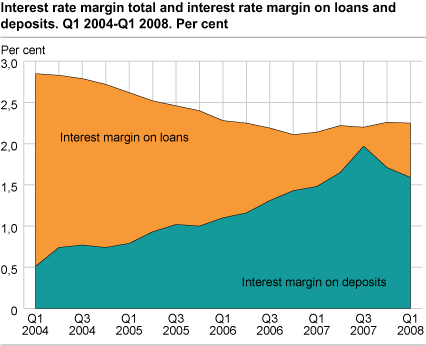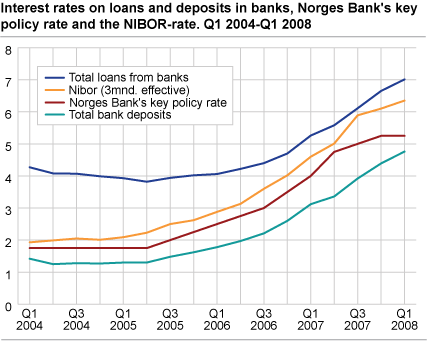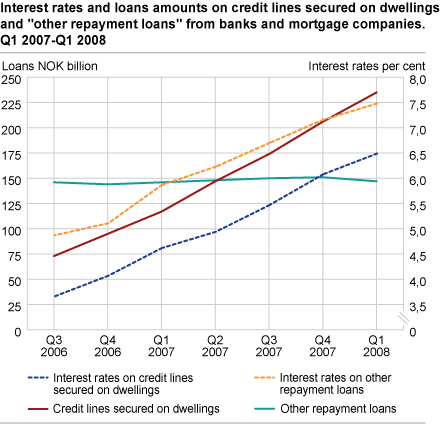Content
Published:
This is an archived release.
Bank interest rates increase more than key rate
During the past two quarters, interest rates on loans and deposits in banks have increased more than Norges Bank’s key policy rate. There was a small decline in the banks’ interest rate margin in the first quarter of 2008.
The average interest rate on loans from banks increased by 0.36 percentage points to 7.01 per cent in the first quarter of 2008, while the deposit rate increased by 0.36 percentage points to 4.76 per cent. Hence the interest margin fell by 0.01 percentage points to 2.25 per cent.
From the first quarter of 2004 to the third quarter of 2007, the average lending and deposit rates increased less than the key policy rate. However, in the past two quarters the increase in the banks’ interest rates has been higher than the increase in the key policy rate. There was no increase in the key policy rate in the first quarter of 2008, but the banks have adjusted their lending and deposit rates to the increase in the key policy rate in December 2007 and to increased money market rates.
The banks’ average interest margin on loans has increased in the past two quarters. However, from the first quarter of 2004 to the third quarter of 2007, the interest margin fell in every quarter. The interest margin on repayment loans and credit lines secured on dwellings increased by 0.12 and 0.16 percentage points respectively in the first quarter of 2008. The deposit margin fell in the last two quarters following an increase in every quarter from the fourth quarter of 2005 to the third quarter of 2007.
| 31.03.2008 | 31.12.2007 | 30.09.2007 | 30.06.2007 | 31.03.2007 | Change 1'st quarter |
Change last year |
|||||||||||||||||||||||||||||||||
|---|---|---|---|---|---|---|---|---|---|---|---|---|---|---|---|---|---|---|---|---|---|---|---|---|---|---|---|---|---|---|---|---|---|---|---|---|---|---|---|
| Total loans from banks | 7.01 | 6.65 | 6.11 | 5.58 | 5.26 | 0.4 | 1.8 | ||||||||||||||||||||||||||||||||
| Total bank deposits | 4.76 | 4.39 | 3.92 | 3.36 | 3.12 | 0.4 | 1.6 | ||||||||||||||||||||||||||||||||
| Banks' interest rate margin (1-2) | 2.25 | 2.26 | 2.19 | 2.22 | 2.13 | 0.0 | 0.1 | ||||||||||||||||||||||||||||||||
| Lending rate, mortage companies | 6.11 | 5.63 | 5.18 | 4.74 | 4.44 | 0.5 | 1.7 | ||||||||||||||||||||||||||||||||
| Lending rate, life insurance companies | 5.87 | 5.82 | 5.42 | 5.08 | 4.79 | 0.1 | 1.1 | ||||||||||||||||||||||||||||||||
| Lending rate, state lending institutions | 4.34 | 4.26 | 3.90 | 3.65 | 3.38 | 0.1 | 1.0 | ||||||||||||||||||||||||||||||||
| Total loans from financial corporations2 | 6.66 | 6.31 | 5.81 | 5.31 | 4.99 | 0.3 | 1.7 | ||||||||||||||||||||||||||||||||
| The Norwegian Public Service Pension Fund | 5.61 | 5.09 | 4.83 | 4.31 | 4.06 | 0.5 | 1.6 | ||||||||||||||||||||||||||||||||
| Nibor (3mnd. effective)3 | 6.35 | 6.10 | 5.89 | 5.01 | 4.60 | 0.3 | 1.8 | ||||||||||||||||||||||||||||||||
| Deposit margin (8 - 2) | 1.59 | 1.71 | 1.97 | 1.65 | 1.48 | -0.1 | 0.1 | ||||||||||||||||||||||||||||||||
| Lending margin (1 - 8) | 0.65 | 0.55 | 0.22 | 0.57 | 0.66 | 0.1 | 0.0 | ||||||||||||||||||||||||||||||||
| Banks. Repayment loans secured on dwellings | 6.72 | 6.35 | 5.78 | 5.26 | 4.95 | 0.4 | 1.8 | ||||||||||||||||||||||||||||||||
| Banks. Credit lines secured on dwellings | 6.51 | 6.10 | 5.48 | 4.96 | 4.64 | 0.4 | 1.9 | ||||||||||||||||||||||||||||||||
| Banks. Lending margin repayment loans secured on dwellings (9 - 8) | 0.37 | 0.25 | -0.11 | 0.25 | 0.35 | 0.1 | 0.0 | ||||||||||||||||||||||||||||||||
| Banks. Lending margin on credit lines secured on dwellings (10 - 8) | 0.16 | 0.00 | -0.41 | -0.05 | 0.04 | 0.2 | 0.1 | ||||||||||||||||||||||||||||||||
| Mortgage companies. Repayment loans secured on dwellings | 6.58 | 6.23 | 5.68 | 5.08 | 4.78 | 0.4 | 1.8 | ||||||||||||||||||||||||||||||||
| Mortgage companies Credit lines secured on dwellings | 6.51 | : | : | : | : | 0.4 | 1.9 | ||||||||||||||||||||||||||||||||
| Life insurance companiess. Repayment loans secured on dwellings | 6.16 | 6.07 | 5.51 | 4.82 | 4.22 | 0.1 | 1.9 | ||||||||||||||||||||||||||||||||
| State lending institutions. Repayment loans secured on dwellings | 4.66 | 4.52 | 4.39 | 4.21 | 4.07 | 0.1 | 0.6 | ||||||||||||||||||||||||||||||||
| Financial corporations total: Repayment loans secured on dwellings | 6.57 | 6.22 | 5.69 | 5.18 | 4.88 | 0.4 | 1.7 | ||||||||||||||||||||||||||||||||
| Financial corporations total: Credit lines secured on dwelllings | 6.51 | 6.10 | 5.49 | 4.96 | 4.64 | 0.4 | 1.9 | ||||||||||||||||||||||||||||||||
| Housing loans total from financial corporations | 6.56 | 6.20 | 5.66 | 5.16 | 4.86 | 0.4 | 1.7 | ||||||||||||||||||||||||||||||||
| Norges Banks foliorente | 5.25 | 5.25 | 5.00 | 4.50 | 4.00 | 0.0 | 1.3 | ||||||||||||||||||||||||||||||||
| Dagslånsrenten | 6.25 | 6.25 | 6.00 | 5.50 | 5.00 | 0.0 | 1.3 | ||||||||||||||||||||||||||||||||
| 1 | Weighted average interest rates incl. commissions on NOK loans from banks and other financial corporations. Weighted average interest rates on deposits in banks from non-financial enterprises, households and local government 1). Weighted average interestmargins in banks. Per cent per annum. |
| 2 | Includes banks, mortgage companies, life insurance companies and state lending institutions. The Norwegian Public Service Pension Fund is not included. |
| 3 | Source: Norges Bank. |
Mortgage companies had largest increase in lending rates
In the first quarter of 2008, the interest rates on loans from mortgage companies increased more than the interest rates on loans from banks, while the interest rates on loans from life insurance companies and state lending institutions increased less than the interest rates in banks. One reason for the relatively high increase in interest rates on loans from mortgage companies is the strong growth in loans secured on dwellings, which have higher interest rates than other loans from mortgage companies (most “other loans” from mortgage companies are distributed to municipalities with good security).
Due to the new regulations concerning bonds with priority, many banks have transferred parts of their most secured housing loans to mortgage companies. Some banks and bank associations have also established new mortgage companies in order to transfer portfolios of loans that are used as security for their bonds with priority. Credit lines secured on dwellings are now also offered by mortgage companies. The average interest rate on repayment loans secured on dwellings from mortgage companies is slightly lower than interest rates on such loans from banks while the interest rates on credit lines secured on dwellings are the same in mortgage companies as in banks.
Lower interest rate on consumer loans?
From the first quarter of 2007 to the first quarter of 2008, the amount of credit lines secured on dwellings doubled, while repayment loans secured on dwellings remained at almost the same level. One explanation is that borrowers prefer more flexible loans.
Another reason may be that many borrowers with good security choose to finance their consumption by credit loans secured on dwellings instead of ”other repayment loans” without a mortgage. Credit lines secured on dwellings have lower interest rates than “other repayment loans” from banks. “Other repayment loans” from banks have usually been regarded as consumer loans. The amount of “other loans” fell in the first quarter of 2008 and is now at about the same level as in the first quarter of 2007.
|
The development in banks’ interest rates is affected by Norges Bank’s key policy rate and the NIBOR rate. Pursuant to the Financial Contracts Act, banks are obliged to give notice to customers of interest rate changes six weeks in advance. As a result, there is often a delay between changes in Norges Bank’s key policy rate and changes in the banks’ interest rates on loans and deposits.
In state lending institutions, the interest rates on loans are adjusted less frequently than in commercial financial corporations. The Norwegian State Housing Bank and the Norwegian State Educational Loan Fund’s interest rate on loans follows the market rates, but with a three to six-month delay. In addition, a higher share of loans from state lending institutions is fixed-interest loans.
The interest margin is the difference between banks’ average lending and deposit rates. The lending margin is defined as the difference between banks’ interest rate on loans and the NIBOR rate. The interest margin on deposits is defined as the difference between the NIBOR rate and banks’ interest rate on deposits. Banks’ net interest income is defined as interest income less interest expenses in the profit and loss accounts. |
Tables
The statistics is now published as Interest rates in banks and mortgage companies.
Contact
-
Statistics Norway's Information Centre
E-mail: informasjon@ssb.no
tel.: (+47) 21 09 46 42



